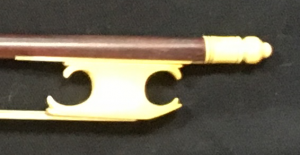The German term Tupfer refers to a technique similar to col legno battuto where, rather than the string being struck with the wood of the bow, the string is tapped or “dapped” with the screw of the bow. The string can be muted or dampened with the left hand so that the pitch of the contact point of the screw on the string is audible.
To my knowledge, there is no recorded historical use of Tupfer on the baroque violin. The technique appears rarely in music for the modern violin, the most frequent examples appearing in the music of Helmut Lachenmann, particularly in his Toccatina for solo violin (Lachenmann, 1986, p. 2).
Tupfer on the baroque violin:
On the modern violin, Tupfer relies largely on the immediate resonance of the metal screw of the bow coming into contact with the metal string. Most historical bows have a screw, or in the case of a clip-in frog,[1] a button, made of ivory, bone or wood rather than metal. One might have assumed that this difference of materials, combined with raw-gut strings, would render Tupfer impractical on the baroque violin. However, the results are almost as loud as with the metal strings and metal screw of a modern violin and bow. In the case of a particularly ornate button, such as the one shown in Figure 5.1 below, the string may be struck with another part of the frog. I have found no example of this technique in music for the baroque violin, either old or new. However, I employ the technique in improvisations and believe it could be used successfully in future repertoire.
Figure 5.1 – ivory button on high baroque bow made by Daniel Latour, belonging to the author
The following is an example of Tupfer on the baroque violin, first with an ivory button, then a wooden button, then a wooden frog.
Video example 5.1 – Tupfer with ivory button, wooden button, then wooden frog
Suggested notation:
Square note head combined with “Tupfer” written above the stave, as in Figure 5.2 below.
Figure 5.2 – example of a possible notation for a Tupfer passage
___________________________________________________________________________________________________
[1] Clip-in frogs achieve tension via a slide mechanism rather than a screw mechanism. Therefore, they have no screw, rather a button at the end of the bow that is fixed to the stick.

